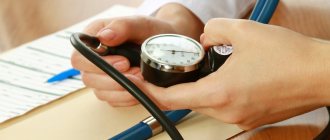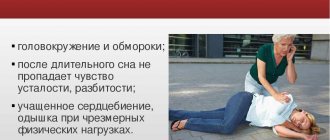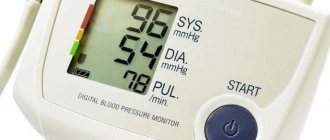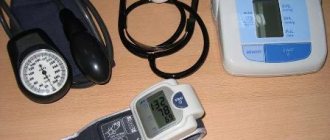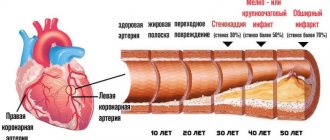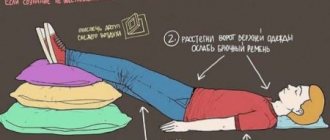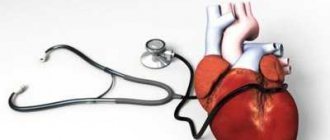Conservative therapy
If lifestyle correction does not help, the pressure remains the same or rises, increasing to 140 to 120 mm, the only way out is to prescribe medications that have antihypertensive properties.
In medical practice, there are 5 groups of drugs that are prescribed to lower blood parameters. Diuretics remove excess water from the body, thereby stabilizing blood pressure within acceptable limits. Calcium antagonists are aimed at blocking calcium channels, thereby preventing the contraction of blood vessels. The impact leads to an increase in the lumen of blood vessels, restoration of full blood circulation.
Angiotensin-converting enzyme inhibitors are first-line tablets that can be taken for a long time, and can also be used as quick-acting drugs.
The treatment regimen includes calcium antagonists and adrenergic blockers. The latter stop the effect of adrenaline on blood vessels, slow down the pulse, and reduce the production of hormonal substances in the body - adrenaline and norepinephrine.
Types of diuretics:
- Thiazide type. The cheapest medications, along with the removal of water, get rid of potassium, which is vital for the normal functioning of the heart and blood vessels.
- Loop type. It is acceptable to drink for a short period of time; long courses are not included.
- Potassium-sparing type. Prescribed against the background of potassium deficiency.
Medicines are characterized by different principles of action, as a result of which they are able to simultaneously influence several factors leading to increased blood pressure. If you want to purchase a safe product with a mild effect on the cardiovascular system, then it is best to use the Normalife dietary supplement.
The effectiveness of conservative treatment is determined by two criteria. The first is good tolerability, absence of new symptoms. The second is reducing the SD and DD to the required values.
davleniya.net
Folk remedies
You can also influence your blood pressure at home. Products made from ginger, honey, aloe, fireweed, lemon or celery are excellent for this. Strong tea or coffee also has a good effect.
Herbal tinctures - valerian, peony and motherwort - help normalize the condition. You can also resort to foot baths. The water temperature should be 45 degrees, a few drops of rosemary essential oil and 1 spoon of sea salt are dissolved in the water. The effect will be enhanced if the bath has a hydromassage effect. These baths should be taken for no more than 20 minutes.
Rosemary leaves are also a good helper for blood pressure. 5 g of leaves are crushed and poured into a glass of boiling water. Leave for 15 minutes. You can drink this drink 3 cups a day.
Another rosemary tincture. A tincture based on dry white wine (500 ml) is made from 80 g of leaves. The ingredients must be mixed and hidden in a dark, warm place for 5 days. You should take one tablespoon twice a day before meals.
Correct body position during sleep. The head should be higher than the rest of the body. If this is not the case, then the person loses a lot of sodium acid, which leads to a decrease in blood pressure due to a decrease in oxygen in the blood.
At 11080 you may feel sick and dizzy
As mentioned above, a decrease in the pulse difference between systole and diastole is accompanied by unpleasant symptoms, among which the most common are severe headaches (up to the development of migraines) and dizziness.
If the pressure is 110 over 80, you have a headache, your general health worsens, you feel stuffiness in your ears, and tremors in your limbs. What might these symptoms indicate?
This suggests that peripheral vascular resistance is high, while the pressure generated by the heart is low. If such indicators persist for a long time, this leads to insufficient oxygen and nutrients reaching the heart, brain and kidneys. As a result, ischemia and tissue hypoxia develop, and metabolism is disrupted. A common parallel symptom is cold extremities, a subjective feeling of coldness in the arms or legs. Against the background of these processes, disturbances in the functioning of the central nervous system may develop.
Prolonged hypoxia of organs and tissues is fraught with changes in their functions, the development of stagnation, which in some cases creates conditions for the development of infectious inflammation (for example, in the gall bladder, in the prostate gland, in the intestines).
If, with a pressure reading of 110 over 80, you feel dizzy, feel nauseous, or general weakness, then these symptoms may also be a sign of temporary malaise. Take a comfortable horizontal position, calm down and get some sleep. Experts do not rule out that after rest the condition will normalize and unpleasant symptoms will remain a thing of the past.
How to maintain normal blood pressure
Any cardiologist will tell you that if hypertension can be called a lifestyle disease (in most cases), then lifestyle should be changed. The program is often extensive, but it’s impossible without it. If you are healthy, but you yourself realize that you want to change a lot of things regarding food and physical activity, it’s time to start.
10 points to help keep blood pressure normal:
- Monitor your eating schedule carefully. This means that in rare cases you need to allow yourself to eat on the run, whatever you like, irregularly. Create a specific eating schedule: for example, breakfast an hour after waking up, lunch, snack, dinner. There may be changes in all this, some people should eat almost immediately after waking up, while others cannot have breakfast before 11-12. But the regime must be clear and stable; it will avoid breakdowns.
- Stew, boil, bake, steam. But don't fry! At least try to do this rarely. All the arguments in favor of tasteless and meager proper nutrition are shattered by dozens of gorgeous recipes without frying, without unnatural sauces, etc. The first week, exclude, for example, fried meat and potatoes. In the second week, stop frying vegetables - vegetables for soup can be sautéed. Next, you will gradually get used to the taste of baked dishes, etc. Remember that you can fry scrambled eggs without oil (in a special frying pan), and other dishes can also be prepared this way.
- Don't overeat. Perhaps it is worth starting from this point. As soon as you start transmitting, you are, figuratively speaking, starting a self-destruction program. And based on how many people today are overweight and obese, overeating is an acute problem. You need to fight it by reducing portions. First, this measure, and then the dishes themselves change - you will have to count calories at first (if you have a goal to lose extra pounds). After overeating, a person does not feel light or strong; on the contrary, he is drowsy, wants to move less, and the thought process is not so active.
- Move! Buy a fitness bracelet, it is inexpensive, and on the way to rapid changes for the better it will become your friend. If we take into account the fact that a person must walk about 7-8.5 thousand steps per day, then this kind of bracelet with a pedometer function will be your controller. Over time, you will understand which routes are more convenient, when you are missing steps for the day, when you have met your quota, etc. These are basic requirements, at least walking at a brisk pace should prevent you from physical inactivity. Then you can add fitness, sports games, dancing, whatever suits you best.
- Drink 1.5 liters of water per day. But this requirement is conditional: if more than 1 liter is too much for you, do not force yourself. If 1.5 liters is not enough, increase the daily volume. Try not to get carried away with black tea and coffee; you can drink more herbal teas, just minimize the amount of sugar.
- Never jump out of bed abruptly. Do a short warm-up right in bed, stretch your body gently, without sudden movements. Work all the main areas: from your fingertips to your neck.
- Accustom yourself to a contrast shower. This is an excellent vascular workout that is generally beneficial for the body. Spend about 15 minutes a day on it and you will be in good shape. In addition to the fact that the blood vessels will be stable in terms of pressure, excessive sweating will also decrease (if such a problem exists).
- Learn to respond correctly to stress. It is the cause of our misfortunes, illnesses and depressions only if we experience it too acutely, multiply its possible consequences in our minds, and intensely reflect. As you can see, a person also has to pay for a developed consciousness: you can fantasize so much negativity for yourself, turn the situation around in such a way that it’s time to actually fall into depression. Maintain clarity of mind, clarity of logic, solve problems as they arise, and do not give yourself over to emotions.
- Be an organized person. Our body is the greatest biological system. Perhaps imperfect, but even medical geniuses don’t know much about it. But it is already known for sure that the human body loves clear rhythms, consistency, and organization. If you don't have a daily routine, if you go to bed at different times, sooner or later he will start to rebel. And increased blood pressure is just one of the common manifestations of this rebellion. Acquire healthy habits, get up and go to bed at the same time, and exercise on a schedule.
- Take care of your mental health. It is an integral component of the overall understanding of health. A person often needs a psychologist no less than a therapist. Internal conflicts, according to the opinion of many scientists, lead to somatic dysfunctions. Psycho-emotional instability (especially for women) very often leads to pressure surges, disruptions of certain hormone-determining cycles, and neurological and neurocutaneous pathologies.
A blood pressure of 110 over 80 is normal in the vast majority of cases. This is a good indicator that you should strive to maintain for as long as possible.
And the above 10 points will help you with this if you follow them honestly. Worth a try!
Reasons for pressure readings 11080
A decrease in systolic pressure can be due to various reasons. If it is permanent and accompanied by pathological symptoms, you should not hesitate to go to the doctor. Because this may indicate serious health problems. If the maximum values decrease occasionally, slightly, and do not cause concern, they are provoked by external factors and should soon stabilize. The cause of the decline in indicators is presented in the table:
Symptoms of low systolic readings:
- weakness;
- rapid pulse;
- lack of air;
- weather sensitivity;
- irritability;
- migraine;
- vomit;
- dizziness;
- decreased performance;
- absent-mindedness;
- darkening of the eyes;
- sweating;
- drowsiness;
- chilliness of the limbs;
- feeling of stuffiness;
- nausea;
- fatigue;
- emotional instability;
- depression;
- tearfulness;
- memory impairment;
- pallor;
- loss of coordination of movements;
- dizziness;
- stuffy ears;
- Bad mood;
- sensitivity to temperature changes;
- acrocyanosis;
- disorientation in space;
- headache;
- lethargy;
- swelling;
- suffocation;
- pulse cannot be felt;
- destruction of the vitreous body;
- sleep disorder;
- poor health in the warm season;
- a woman may experience menstrual irregularities;
- brokenness;
- discomfort in the heart area;
- loss of consciousness.
Return to contents
With reduced systolic pressure, the load on the left side of the heart increases and vascular tone increases. This can cause the development of various pathologies, although with low blood pressure the risk of fatal heart pathologies is much lower than with high blood pressure. Reduced maximum pressure can provoke:
- bad feeling;
- unpleasant symptoms;
- fainting;
- hypertension;
- hypotensive crisis;
- tachycardia (pulse increased);
- neurocirculatory dystonia;
- restriction of nutrients for different organs and systems;
- vegetative-vascular dystonia;
- cardiovascular pathologies;
- intrauterine growth retardation in pregnant women;
- difficult birth.
Return to contents
To measure pressure, a special device is used - a tonometer. It can be mechanical or electrical. To obtain objective indicators, you should not take medications or be physically or emotionally overexerted before taking measurements. It is necessary to measure the pressure on both arms several times a day. When performing measurements, in order to obtain objective data, you must follow certain rules:
- take a sitting position;
- relax;
- place your hand at chest level;
- don't talk;
- don't move;
- don't worry;
- 30 minutes before the procedure, do not eat, drink, or smoke;
- the bladder should be empty.
Return to contents
Causes
The generally accepted norms for blood pressure are 120 per 80 mm Hg. Art. The first numbers when measuring pressure are indicators of systolic (at the moment of maximum contraction of the heart) pressure, and the lower ones are diastolic (pressure in the arteries when the heart muscle relaxes). The difference between these readings should not exceed 30-40 units.
The amount of pressure may depend on the following factors:
- blood clotting;
- blood thickness;
- elasticity of the walls of blood vessels;
- dilatation or constriction of blood vessels;
- force of heart contraction.
If a person’s blood pressure is constantly elevated, it is hypertension, and if it is low, it is called hypotension.
There is a list of certain human health conditions when a blood pressure of 110 over 80 is normal. This includes:
- last trimester of pregnancy;
- asthenic physique;
- professional athletes;
- teenagers.
Sometimes such pressure readings can indicate that a person has weak heart muscles, which can lead to a heart attack. To prevent such consequences, you should consult a doctor.
The causes of low systolic pressure are divided into:
- periodic changes - overwork, being in a stuffy room, dehydration, climate change, pregnancy, alcohol, stress;
- constant changes - heredity, hypotension, brain injury, diabetes mellitus, bradycardia, myocardial dystrophy, intoxication.
If a person understands that his blood pressure is constant, which is most likely accompanied by pathological changes in the body, then he should not delay going to the doctor.
Etiology of borderline hypertension
Blood pressure is indicated by two numbers.
In a pathological condition, an isolated excess of the systolic value may be detected, while the second remains within normal limits; Only the diastolic reading can rise. But most often both increase. A blood pressure of 140 over 80 is normal. However, a slight excess of the parameters leads to the occurrence of first-degree hypertension. Therefore, already at this stage it is recommended to take measures aimed at preventing an increase.
A healthy body will never undergo such a jump, even under severe shock or a stressful situation; accordingly, they speak of borderline hypertension, regardless of the fact that the numbers are within acceptable limits.
Medicine knows many causes and factors contributing to the occurrence of the disease. When it is not possible to establish the true “culprit” of the increase to 142-144/80-85 mm, an essential disease is diagnosed.
When the pressure is 145 over 85, then the probable causes are:
- Overweight or obesity. Each kilogram has an impact on DM and DD, as a result of which the parameters increase. An extra 30 kilograms of weight is a direct path to chronic disease.
- Heredity, kidney pathologies, bad eating habits, inactive lifestyle, drinking alcohol, smoking, etc.
- The age of the person. Over the years, internal organs wear out, as well as the walls of arteries and blood vessels, becoming less elastic and durable, resistance to blood flow increases, which leads to an increase to 140/100 mm.
Medicines for the treatment of concomitant pathologies can cause an increase, for example, taking hormonal drugs for a long time, as a result, blood pressure increased and stopped at 145 to 95.
If the patient’s blood pressure is 140 over 100, then it can be brought down using non-drug methods - changing diet, quitting smoking/alcohol, table salt, etc. When the readings are 140 to 110 or higher, they are prescribed to take pills.
Lifestyle correction is the basis of therapy for blood pressure 140 per 100 mm. Strict adherence to all tips will allow you to achieve a result of 130/70-80 mm.
Low or high blood pressure 110 to 80 mm Hg. Art.?
According to WHO, normal human blood pressure is 120/80 mmHg. Art. In this case, pulse pressure - the difference between the upper (systolic) and lower (diastolic) values should be 30–40 mm Hg. Art. For medical workers, the value is 120 to 80 mmHg. pillars are not always the only reference point for identifying deviations from the norm.
These indicators are conditional and may fluctuate slightly depending on various factors:
- age;
- body features;
- physiological or emotional state;
- weather or climatic conditions;
- presence of chronic diseases;
- individual characteristics of the body.
In modern medicine, the following fluctuations in values are considered acceptable normal values: systolic - from 91 to 139 mm Hg. Art., diastolic - from 61 to 89 mm. rt. Art.
Based on this, what is a blood pressure of 110 over 80: normal, high or low? For different categories of people the indicators are 110/80 mmHg. column are regarded as normal, and in some cases, in the presence of certain symptoms, they speak of a slight deviation from the norm.
If a person’s readings are considered to be 120/80 or higher, then a pressure of 110/80 is considered to be lower in the upper (systolic) value. This occurs due to insufficient power of the heart muscle when pumping blood through the vessels, that is, a decrease in the pumping function of the heart with normal peripheral vascular resistance.
This phenomenon can occur in older people. The following factors provoke a decrease in systole with normal diastole values:
- heart pathologies (heart failure, valve defects);
- disruption of the endocrine system (hypothyroidism, problems with the adrenal glands, hypoglycemia);
- dehydration of the body;
- large blood loss;
- allergic reactions;
- taking medications;
- stressful situations;
- avitaminosis;
- intoxication of the body (alcohol);
- penetration of bacteria and viruses;
- hormonal imbalances;
- heatstroke;
- renal failure.
A decrease in systolic pressure in pregnant women requires mandatory medical supervision, as it threatens the development of fetal pathology and poses a danger to the life of the mother and child.
On the contrary, in people whose blood pressure is normally 110 over 70 and below (within the above permissible fluctuations), it will be slightly increased in diastole (lower reading). This indicates an increase in peripheral vascular resistance. Normally, with a decreased systolic rate, this should cause a reflex increase in cardiac output and an increase in this indicator (which is why 120/80 is normal). This does not happen with a blood pressure of 110/80. Why? It may also indicate the onset of some kind of heart disease and the risk of developing heart failure in the future.
If a person is concerned about additional symptoms - palpitations, heart pain, fluctuations in blood pressure - it is imperative to consult a therapist or cardiologist.
Blood pressure standards according to WHO classification
The effect of age on blood pressure
Continuing the study, taking into account the above information, we will try to establish: is the above blood pressure value - 100/80 - the norm?
Blood pressure largely depends on age. So, let's look at blood pressure standards by age. In infancy, for example, for one-year-old babies 96/66 is the norm, also the norm for men from 40-49 years old is 135/83, and for old people 80 years of age and above, their own norm is 147/82. For women, these figures are slightly lower - by 5-10 units. During pregnancy, blood pressure is often elevated. It changes several times during the day. Its indicator depends on many factors:
- One-time physical activity and sports lead to increased blood pressure.
- Taking medications can lead to both an increase and a decrease.
- Time of day - at night blood pressure is lower.
- Taking stimulants, such as alcohol, tea, coffee - an increase followed by a sharp decrease.
- Psychological state: stress provokes surges in blood pressure.
Is it dangerous?
As usual, hypotension poses fewer threats than hypertension (tachycardia, rapid heartbeat), however, both of these conditions are critical for a person and should not be ignored. In the case of hypotension, one can state weakness of the heart muscle, and if the heart cannot cope with the load, then the person loses consciousness. At a pressure of 105 over 75, this may not happen, but if the trend continues, the scenarios may be different.
With sudden physical exertion and psycho-emotional factors, hypotension (105 to 80 and below) threatens:
- noticeable deterioration in health;
- fainting;
- tachycardia;
- VSD;
- heart pathology;
- various pathologies during pregnancy and childbirth.
Thus, clinical hypotension poses a danger to the body, however, only if its symptoms are pronounced, bring discomfort to the person and lead to a significant deterioration of the condition.
In other cases, this is either normal pressure or a temporary deviation, which is not felt in any way and is corrected naturally.
Reasons for reduced PD
Low pulse pressure does not always develop due to damage to the cardiovascular system. But more often than not it turns out that way. An approximate list of development factors:
Heart attack
Especially if the left ventricle is affected. Usually we are talking about a slight extent of damage to cardiac structures (microinfarction). Therefore, the indicator drops insignificantly, being within 25-30 mm Hg or a little more.
Contractility is still present, so the body is supplied with blood to an acceptable extent.
With a large area of damage, intense disruption of the release into a large circle occurs. Cardiac shock and death are possible. In such a situation, pulse pressure drops to critical levels.
The pathological process needs to be viewed in exactly this way. Accordingly, a slight decrease in PP is associated with a relatively favorable prognosis for recovery after an emergency condition.
Aortic stenosis
Usually at valve level. There is an impossibility of normal blood ejection into the largest artery. Blood stagnation occurs in the left ventricle. This leads to constant overstrain of cardiac structures.
As it progresses, dilatation (expansion) of the organ chambers occurs. Contractility is insufficient, the volume of liquid connective tissue drops significantly for a whole group of reasons: not only stenosis is to blame, but also changes in the anatomy of the heart.
Pulse pressure decreases as a result of incomplete contraction, with short periods of rest between each cycle. Over time, the process only gets worse, so the likelihood of recovery depends on the moment the defect is discovered. The later, the worse the prognosis.
Neurological abnormalities
To a small extent, cardiac activity is controlled by the brain. If the functioning of cerebral structures is impaired, arrhythmias and insufficiency of myocardial contractility may develop.
This is a characteristic feature of vegetative-vascular dystonia. In origin it is a symptomatic complex, and not an independent diagnosis.
The diagnostic task becomes more complicated: when identifying VSD, it is also necessary to discover its cause.
Mitral valve insufficiency
It delimits the left atrium and ventricle, passing blood in measured quantities strictly in one direction. When an anatomical structure is disrupted, a reverse current or regurgitation occurs, which ends in a well-known manner.
Dilatation occurs, followed by cardiomyopathy, a decrease in myocardial contractility, a drop in blood output, and therefore pulse pressure. And there is already one step before progression, cardiac arrest and death.
The scenario is excluded with timely surgical treatment with restoration of the integrity of the mitral valve or prosthetics (preferably).
Heart failure
Both in the first and second stages. The patient feels minimal discomfort, but the process actively continues, destroying the system. Diagnostics is carried out using instrumental methods.
Recovery requires combating the root cause, as well as symptomatic therapy to eliminate manifestations.
Other heart defects, congenital and acquired
They require timely surgical treatment. They are not always detected immediately, and therapy is not needed in all cases.
In order not to miss an important point, it is recommended to undergo preventive examinations with a cardiologist every six months to a year, as well as an ECG and ECHO to detect any abnormalities. The need for therapy is decided on an individual basis.
What to do
If a blood pressure reading of 100 to 80 is normal, then the person will not need treatment. Things are different if a pathological process is observed in the body, which leads to changes in the arteries. Hypertension is characterized by similar symptoms. However, low blood pressure indicates the opposite condition - hypotension.
If a person periodically has a blood pressure reading of 110 over 80, but his condition does not worsen, then nothing needs to be done. You just need to monitor your blood pressure by regularly measuring it with a tonometer. It is also advisable to normalize the time of rest and work, to protect yourself from strong emotional experiences.
A doctor’s help and appropriate treatment are required if, with a low systolic value, a person feels obvious signs of malaise.
First aid
Since most people have a normal systolic pressure of 110 and a diastolic pressure of 80, if a slight deviation is detected, you cannot immediately take medications that can solve this problem.
Cardiologists recommend that patients stop taking medications if their blood pressure drops to 110/80. It is best to try to slightly increase blood pressure with herbal teas or decoctions. It is also advisable to provide the patient with complete rest. This is especially necessary if the malaise was caused by overwork or stress.
Such a slight deviation of blood pressure from the norm does not require medication; you can do it with home remedies
When your blood pressure is 100 over 80 what does it mean?
Hypotension, or low blood pressure, is one of the common diseases that affects mainly young women, teenagers, and older people. When the pressure is 100 to 80 mm Hg. This is one of the signs of this disease - hypotension. With such indicators, drowsiness, dizziness, and fatigue occur. There are situations when a feeling of suffocation may appear, it is difficult to take a deep breath, and there are breathing problems.
What does pressure 100 over 80 mean?
When blood pressure is not more than 105 to 65 mmHg. Art. (or 100 per 60 mm Hg and less in children and also up to 25 years of age), we can confidently say: you are a victim of arterial hypotension, that is, you suffer from decreased vascular tone. In general, blood pressure is considered normal when it is 120 over 80. In a hypotensive person, the upper (i.e., systolic) pressure, as a rule, is no more than 90-100 mm Hg. Art., the lower level (i.e. diastolic) can be up to 40-50 mm Hg. Art.
Such indicators are often observed from childhood in those people who have an asthenic build - tall, with a pale face, thin
For such people, after any overexertion, it is more difficult for the body to recover; they may feel weak, for example, when quickly changing the position of their body, getting out of bed, they do not care about stuffy rooms, they often get motion sickness when driving.
High blood pressure is one of the most popular health complaints, one of the “favorite” diseases among older people. This pathology can explain any changes in well-being, poor mood, and other life difficulties. Blood pressure may drop or rise several times during one day. In general, people’s normal blood pressure is a very individual concept.
Symptoms
In rare cases, the pressure is 110/80 mmHg. Art. accompanied by drowsiness and loss of strength without other, more serious symptoms.
But hypertensive patients with such pressure experience the following symptoms:
- difficulty breathing;
- tachycardia;
- sweaty palms;
- mood lability;
- lack of coordination;
- migraine, dizziness;
- tinnitus;
- jumping spots before the eyes;
- persistent fatigue;
- fainting;
- menstrual irregularities in women.
Is treatment necessary?
A decrease in pressure is accompanied by discomfort, but does not always require treatment. Complex therapy is prescribed only when there is persistently low blood pressure against the background of other pathologies, primarily vegetative-vascular disorders.
If there is a slight drop in pressure, you can cope on your own. Coffee and strong black tea will come to the rescue. It is enough to drink just one cup of a strong brewed drink to notice an improvement in your well-being within 15 minutes. Dark chocolate is also useful for low blood pressure - it stimulates the nervous system, gives a boost of energy and slightly increases blood pressure.
Caffeine medications will help get rid of headaches with low blood pressure. The most accessible and effective drugs:
- Citramon;
- Farmadol;
- Tamipul;
- Solpadeine.
It is enough to take 1-2 tablets for the headache to go away in half an hour. You should not abuse drugs with caffeine, as they can provoke tachycardia. If the patient has an increased heart rate, but also a headache and low blood pressure, it is better to use a cold compress on the head, as the drugs will aggravate the tachycardia.
If the pressure is 110 over 70 and persists for a long time, what to do depends on the symptoms. You should undergo a comprehensive examination by a cardiologist and neurologist. In most cases, such pressure is the result of a disruption of the nervous system, but not the cardiovascular system. Treatment is aimed at restoring the functioning of the nervous system and includes drugs to improve cerebral circulation, vitamins, and sedatives.
At home, you can use tonic medications - these are alcohol tinctures of lemongrass or ginseng. Such drugs are taken three times a day, 20 drops for two weeks.
A cup of strong coffee will restore vigor
Treatment during pregnancy
What is normal blood pressure in pregnant women - it depends on the trimester, so blood pressure readings of 110 over 70 do not always require treatment. Typically, women experience low blood pressure in the first trimester due to toxicosis. Drug treatment is not carried out; the patient is advised to change the regimen and diet.
It is necessary to get enough rest and regularly take walks in the fresh air. This gives a boost of energy and minimizes stress, which often causes low blood pressure in the first trimester.
Nutrition must be balanced. You should eat small portions every 3-4 hours. It is imperative to maintain a drinking regime. During pregnancy, pressure 110 over 70 cannot be treated with drugs and medicinal plants, as this can lead to an increase in uterine tone.
Treatment in the elderly
Is a blood pressure of 110 over 70 normal for an elderly person? It depends on the blood pressure levels that have been observed throughout life. If a patient has suffered from hypotension since youth, there may be low blood pressure in old age.
When hypertension is diagnosed, blood pressure can drop to 110/70 when taking antihypertensive drugs, while the pulse remains within normal limits (80 beats per minute). There is no need to take urgent measures in case of such a violation, but you should consult with your doctor about adjusting your regimen for taking blood pressure medications.
Since blood pressure 110 over 70 is almost normal pressure, there is no specific prevention. If a decrease in blood pressure causes discomfort, you should reconsider your lifestyle.
The influence of pulse on the condition
Along with jumps in blood pressure, heart rate indicators often change. If, with a blood pressure of 110 over 90, the pulsation does not exceed 100 beats per minute, then in most cases there is no cause for concern. This is due to the fact that the body independently tries to normalize systolic blood pressure. But the most adequate pulse is 80 beats.
It is worth considering that rapid pulsation at such pressure levels is not always considered normal. Sometimes this indicates the development of tachycardia and other serious diseases. If palpitations are accompanied by additional symptoms, you should visit a doctor. For example, if a person has a headache and is dizzy, pain appears in the abdominal area, and the feeling of fear increases.
Norm or pathology
Doctors do not give a clear answer to questions about what a pressure reading of 110 to 80 means. Some experts say that this is a completely normal condition. However, they also call this indicator, which means current pressure, a sign of hypotension. More accurate information can be obtained by studying the presence of accompanying symptoms and determining the duration of this condition.
Before moving on to discussing the topic of what to do if there is pressure, you should understand the causes of this condition. A decrease in systolic value can be caused by various factors.
The reasons for a decrease in systolic blood pressure may be the following factors:
- Periodic changes in blood pressure - being in a stuffy room, overwork, alcohol intoxication, psychological trauma, changes in climate zone, excessive physical activity;
- Constant changes in blood pressure - myocardial dystrophy, hypotension, hereditary changes, cardiosclerosis, diabetes mellitus, myocarditis, brain injury.
As you can understand, constant cases of a decrease in one of the blood pressure values should cause alarm. This is because this disorder is usually provoked by painful conditions that affect the functioning of the heart, blood vessels and nervous system.
If the pressure changes briefly and due to external reasons, there is no need to worry
A person's current blood pressure can tell a lot about their health. To understand what it is like at the moment, you should take measurements using a tonometer. This procedure is mandatory if there are symptoms of illness. Pressure with values of 110 to 80 may be accompanied by the following symptoms:
- Rapid pulse;
- Weakness;
- Irritability;
- Dizziness;
- Nausea and vomiting;
- Headache;
- Drowsiness;
- Depression;
- Discomfort in the heart area.
Causes
The reasons for changes in blood pressure can be very different. Doctors name permanent and periodic causes that provoke hypotension. Permanent ones are: hereditary factor, problems with metabolic processes, myocardial pathologies, diseases of the endocrine system, traumatic brain injuries. Periodic reasons:
- Oxygen deficiency due to being in stuffy conditions.
- Intoxication from alcohol.
- Excessive physical activity.
- Dehydration of the body.
- Acclimatization period.
On a note! Low blood pressure is often caused by heat. Experts advise taking a bottle of cold water (with lemon juice) with you during extreme heat.
If your blood pressure suddenly drops sharply, you can take 2-3 sips and sit in a shady place. This normalizes the condition and blood pressure. But with periodic surges, you need to consult a cardiologist.
In an adult
There are several reasons for problems with blood pressure in adults. These are: a stressful situation, overwork and consumption of diuretics or antihypertensive drugs. Endocrine and central nervous system pathologies can cause interruptions in blood pressure. The following reasons are also common:
- Increased sensitivity to weather changes.
- Lack of sleep.
- Excessive physical activity.
If you have problems or develop such symptoms, you should consult a doctor.
In which case, immediately consult a doctor
It is necessary to see a doctor if:
- painkillers do not provide relief;
- severe pain in the head occurred suddenly, explosively;
- there is a prolonged strong tremor of the whole body;
- there is a constant feeling of drowsiness;
- pain in the head appeared after a head or spinal injury;
- headache is accompanied by muscle and joint pain;
- there were problems with speech.
Before the ambulance arrives or before consulting a doctor, you can relieve pain using medications.
Before taking the medicine, it is necessary to determine your blood pressure level.
With low blood pressure, the headache subsides after taking caffeine-containing drugs (Citramon, Askofen, Pentalgin), herbal tonics (ginseng extract, Eleutherococcus) and anticholinergic drugs (Bellataminal).
Experts also recommend:
- drink strong sweet tea or coffee with sugar;
- Take a horizontal position so that your head is level below your feet.
Headache caused by increased blood pressure can be relieved with thiazide diuretics (Diuril, Nakleks), diuretics (Veroshpiron, Diursan).
They also help:
- hot foot baths (water temperature no higher than 45 degrees) lasting 10-15 minutes;
- massage of the back of the head, which is carried out in a circular motion;
- applying mustard plasters to the back of the head;
- rubbing the eyes.
A pressure headache is a symptom that can have a negative impact not only on a person’s well-being, but also pose a lot of dangers. Most diseases that cause blood pressure to deviate from normal are very dangerous and require mandatory treatment. Do not put off visiting a doctor and neglect his advice.
It is important to remember that you can get rid of cephalalgia and pressure only by eliminating their cause. . Source: zdorovya-spine.ru
Source: zdorovya-spine.ru
Treatment with traditional methods
Treatment begins only after the exact cause of the low blood pressure has been established. This should happen under the supervision of a doctor.
He can prescribe a number of physiotherapeutic procedures: massages, circular showers, acupuncture, aromatherapy, but if this does not give any effect, then the doctor prescribes medications of various groups:
- nerve stimulants;
- alpha adrenergic agonists;
- cerebroprotectors (Cinnarizine, Vinpocetine);
- herbal adaptogens (tinctures of lemongrass, ginseng);
- antidepressants;
- tranquilizers.
In case of acute hypotension, cardiotonics and vasoconstrictors (Mezaton, Dopamine) are administered, and saline and colloid solutions are infused.
